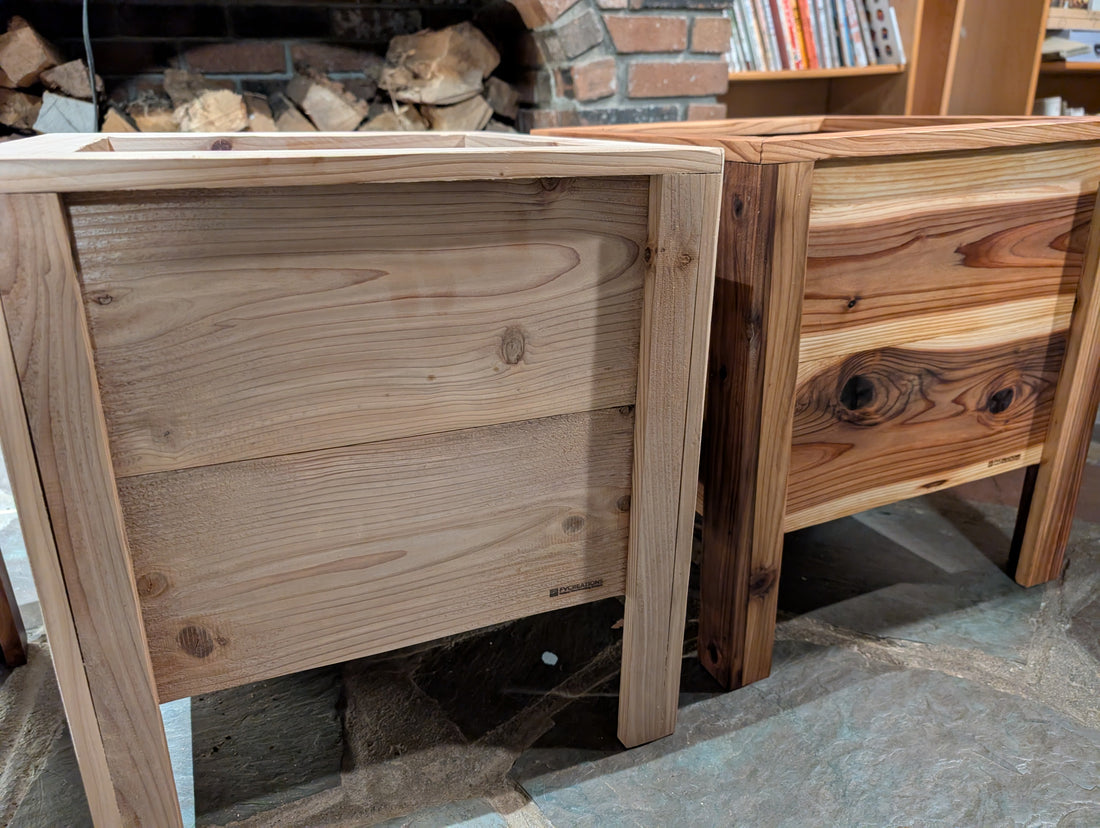
How To Take Care of Outside Furniture And Other Items Made Of Cedar
Cedar is a great wood and is used for house siding, deck boards, garden furniture, planting boxes, arbors- if it's something that lives outside, you can find it made of cedar.
Cedar is famously rot resistant - but it is not immune to rot. You do need to take care of it, to give it that long lasting life you expect from any item made of cedar.
What can you do?
Apply a Protective Finish
Frankly - almost any finish will do and make a difference when compared to untreated cedar. I do advise using non-toxic, natural finishes if you plan to grow herbs or vegetables in the planters, here some Options:
Paint:
If you paint - use a really good outside rated primer first. Then use an outside rated paint that is designed to work with your primer. Maybe choose a primer and paint that has mold growth inhibitor in it.
Personally, painting cedar hurts my soul so I will almost never hide the grain of a cedar board if I can avoid it. However, I do admit that some projects require paint or an opaque stain. If possible, only paint the outside and top. Switch to a good, deep penetrating oil finish for the inside. Paint only covers the surface and lives on top of it, it does not penetrate wood. When paint gets damaged and flakes off, it no longer offers any further protection to wood.
An oil based finish will penetrate and build a deeper layer of protection than paint ever can. Also, oil based finishes are faster and easier to apply than painting the inside of a planter - believe me, I know.
If you need to paint, consider adding a layer of Outdoor Defense Oil as a final coat on top of your paint to give it more protection and longer life span than just paint alone.
Oil Based Finish
It is no secret I work mainly with finishes and paints by The Real Milk Paint Co and that I really like Tung Oil based finishes for the way they make grain pop. Tung oil also creates a water tight barrier if applied correctly and given the time it needs to cure adequately before your cedar item lives outside and starts to get beaten down by the elements.
The finish I use the most outside - and not just on wood - is Outdoor Defense Oil. It is Tung Oil with a solvent (thins the oil and lets it penetrate deeper into the wood) and zink for UV protection - it is my go-to finish 90% of the time. I sometimes use Dark Tung Oil (Dark Half) to give cedar a darker tone, but even then I will go over it with one or two layers of Outdoor Defense Oil because it adds extra protection against the the wood fading and graying out too much.
And, refinishing with tung oil finishes is easy - there no need to strip the previous finish. Just clean the items with soapy water, rinse them off thoroughly, let them dry and just apply the oil on top. It really is that easy. And, RMPCo's tung oil finishes contain no VOCs so you can do your finishing inside and not worry about inhaling harmful organic compounds.
What to avoid
Constant Water Contact
If cedar is outside, water cannot be avoided. What you want to avoid is trapping water against cedar where it has no way to escape and evaporate and the wood has no way to dry out after being wet. This is especially a problem for end grain, as that part of the wood is like a bundle of straws and will more easily absorb water and be slow to release it again. Dripping faucets, leaky gutters overhead, standing water whenever there is a light rain right where you put the item, leaving it out in the path of an automatic sprinkler, etc. - all of that should be avoided if possible.
Ground/Direct Soil Contact
Obviously cedar will be resting on the ground somehow - minimize the area that touches the ground if. Also, if it is possible, avoid having end grain touch the ground or be exposed to too much constant moisture.
Don't Just leave it out Year-Round
If you use a cedar planter and fill it with soil - staple a barrier to the inside. Something like landscape fabric would be great. If possible, use something that is water tight towards the sides of the planter but will let water wick out the bottom. Maybe consider using a grow bag inside the planter - more on that further below.
Put your Cedar planters away in the winter
Moisture is moisture and will impact the any wood - even cedar - but direct soil contact will kill any wood over time (unless the wood is black locust - nothing kills that wood ...). Planters need their soil refreshed regularly anyway, so empty the planter out over winter and put it away, don't leave it out in the elements. Protecting it from the winter weather and letting it fully dry out over the winter will make it last (much!) longer - especially if you re-apply a finish in the spring before you fill it again.
Some of my clients like to use grow bags in their cedar planters as that makes it a breeze to maintain, change, replace and emptying out the planter before putting it away in the winter. There are I like to point them to Botanical Interests' website. I myself am an avid gardener and buy some of my seeds from them. I have no business relationship with them, I am just a customer myself and like their offerings.
